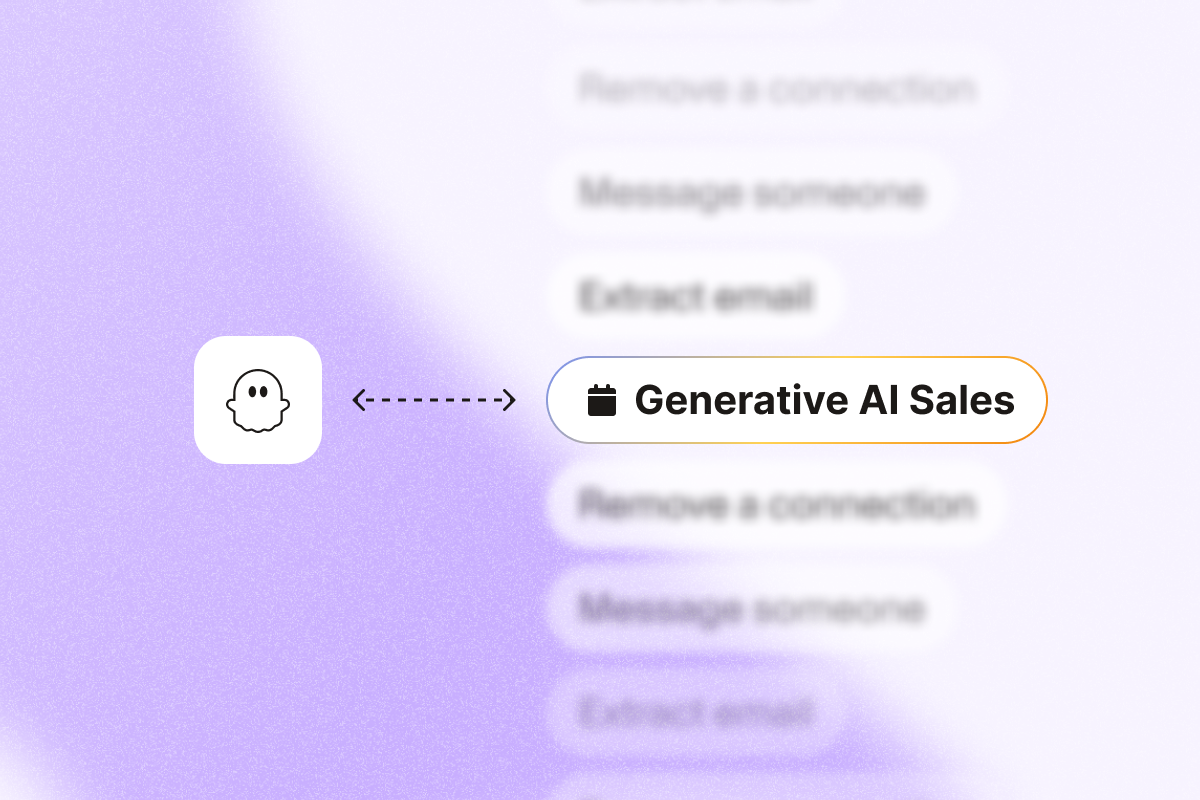Sales teams are reshaping lead generation with generative artificial intelligence (AI), making processes faster, smarter, and more efficient.
Generative AI lets sales reps focus on building relationships instead of manual, time-consuming tasks like crafting outreach messages and analyzing data.
In this guide, we’ll show you how sales teams can use generative AI to improve their workflows, boost their sales efforts, and achieve their goals.
AI highlights
- Generative AI for sales uses advanced algorithms to analyze data, automate sales tasks, and create content, making sales more effective.
- Generative AI tools handle the busywork—like lead generation, qualification, follow-ups, and personalized messages—so you can focus on closing more deals.
- Here are ten ways generative AI can help you in the sales world:
- Find high-quality leads: Use generative AI to automate prospecting and uncover high-potential leads who want to hear from you.
- Prioritize top prospects: AI-powered tools analyze and qualify leads based on key criteria, such as job titles and social media engagement, to tell whether they match your ICP.
- Score leads effectively: Use AI to assign scores to prospects and prioritize contacts that are more likely to convert.
- Personalize outreach at scale: Generate tailored messages with AI tools like the AI LinkedIn Message Writer.
- Automate repetitive tasks: Let AI SDRs handle follow-ups, lead scoring, CRM data enrichment, and scheduling so you can focus on closing deals.
- Scale sales content effortlessly: Use AI to create LinkedIn posts, email templates, and content ideas that resonate with your audience and keep your social selling efforts visible.
- Gain insights from sales calls: AI tools like Gong analyze conversations to highlight customer responses, objections, and opportunities for improvement.
- Deliver tailored sales coaching: AI provides personalized feedback based on performance data, helping reps sharpen their skills and close more deals.
- Predict outcomes and forecast growth: AI tools can analyze deal data and behavior to identify the best sales opportunities and align your efforts for success.
- Spot trends in sales data: Leverage AI to uncover patterns in your metrics, revealing what’s working and where to improve for better results.
- PhantomBuster is a great generative AI tool for sales professionals—it lets you automate sales prospecting, enrich lead data, and personalize outreach.
What is generative AI for sales?
Generative AI for sales refers to AI systems that can create valuable outputs to improve sales performance and streamline the sales process.
These systems use advanced algorithms and machine learning models to analyze large volumes of data, generate content, predict trends, and automate tasks that traditionally require human effort, increasing sales productivity.
This type of artificial intelligence learns from patterns in your data and external sources, such as market research or competitor information.
It creates things like message templates, lead intelligence suggestions, and even customer engagement tips—making outreach faster, smarter, and more effective for your team.
How can generative AI be used for sales
Generative AI can make sales teams faster, more efficient, and better equipped to close deals.
Here’s how it helps:
- Take care of repetitive tasks: Use AI sales assistants to handle email templates, follow-ups, and scheduling so you can focus on conversations that move deals forward.
- Make every interaction personal: Tailor messages, proposals, and recommendations to each prospect without spending extra time.
- Boost sales productivity: Quickly identify your top leads, cut down on admin work, and spend more time selling.
- Streamline workflows: Connect AI with your CRM to keep customer data, insights, and outreach aligned in one place.
- Turn leads into customers: Use insights to craft targeted messages and campaigns that convert better.
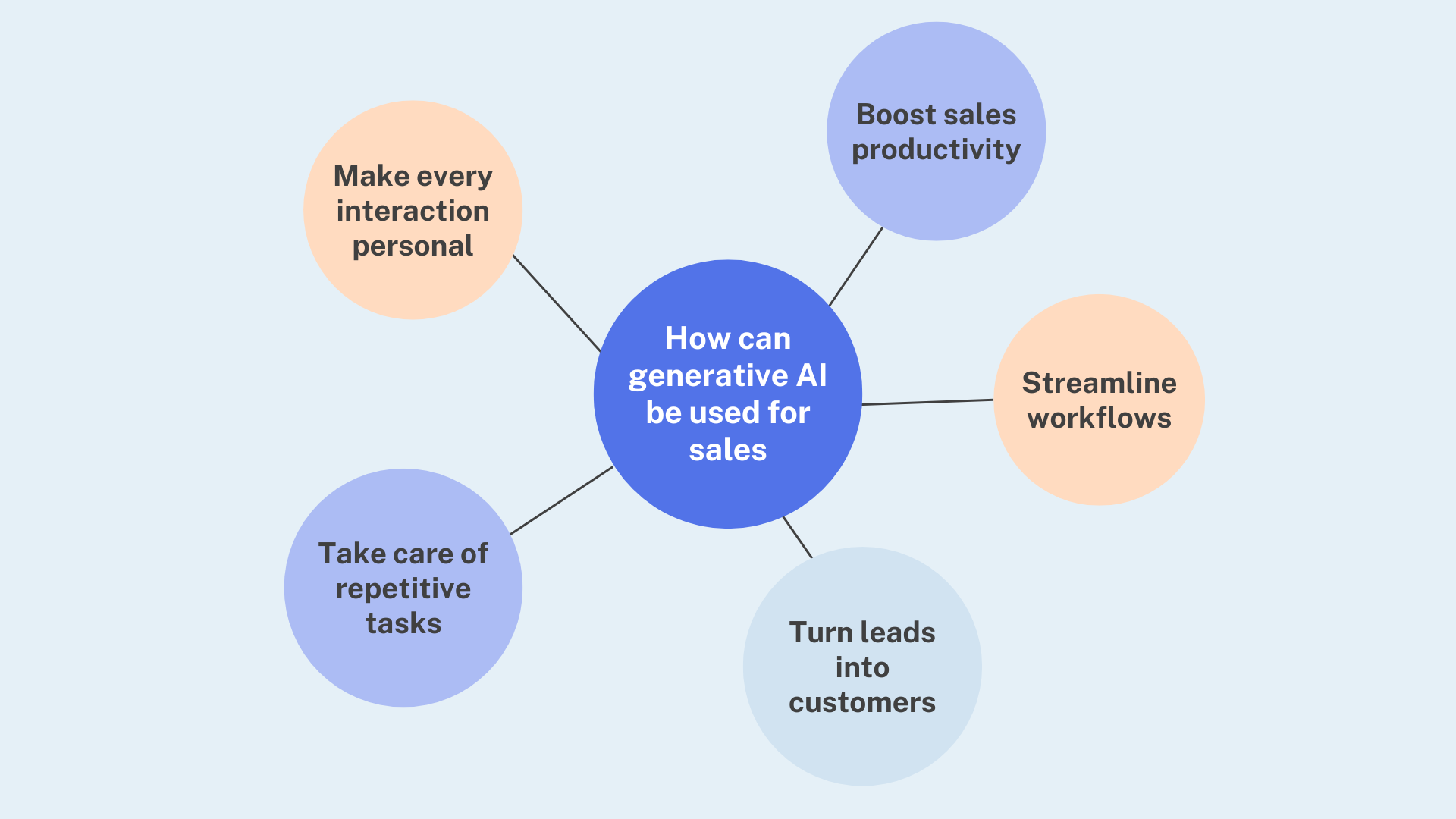
Top 10 generative AI use cases for sales reps
Generative AI transforms how sales reps work by streamlining tasks, improving personalization, and uncovering insights.
Here are the ten most impactful use cases for generative AI for sales.
1. Find high-quality leads to grow your sales pipeline
Finding the right leads is essential for building a strong sales pipeline. Generative AI can help you automate the sales process and uncover high-potential prospects faster.
Here’s a practical example of a LinkedIn workflow by Jérémy Grandillon:
- Start by using a tool like PhantomBuster to collect engagement data from LinkedIn, such as people who like and comment on your competitors’ or industry influencers’ posts.
- Extract detailed profile data, including emails and job titles, and build a targeted lead list.
- Take it a step further by enriching these profiles with AI to reveal key insights like tone of voice preferences, common challenges, or buying intent.
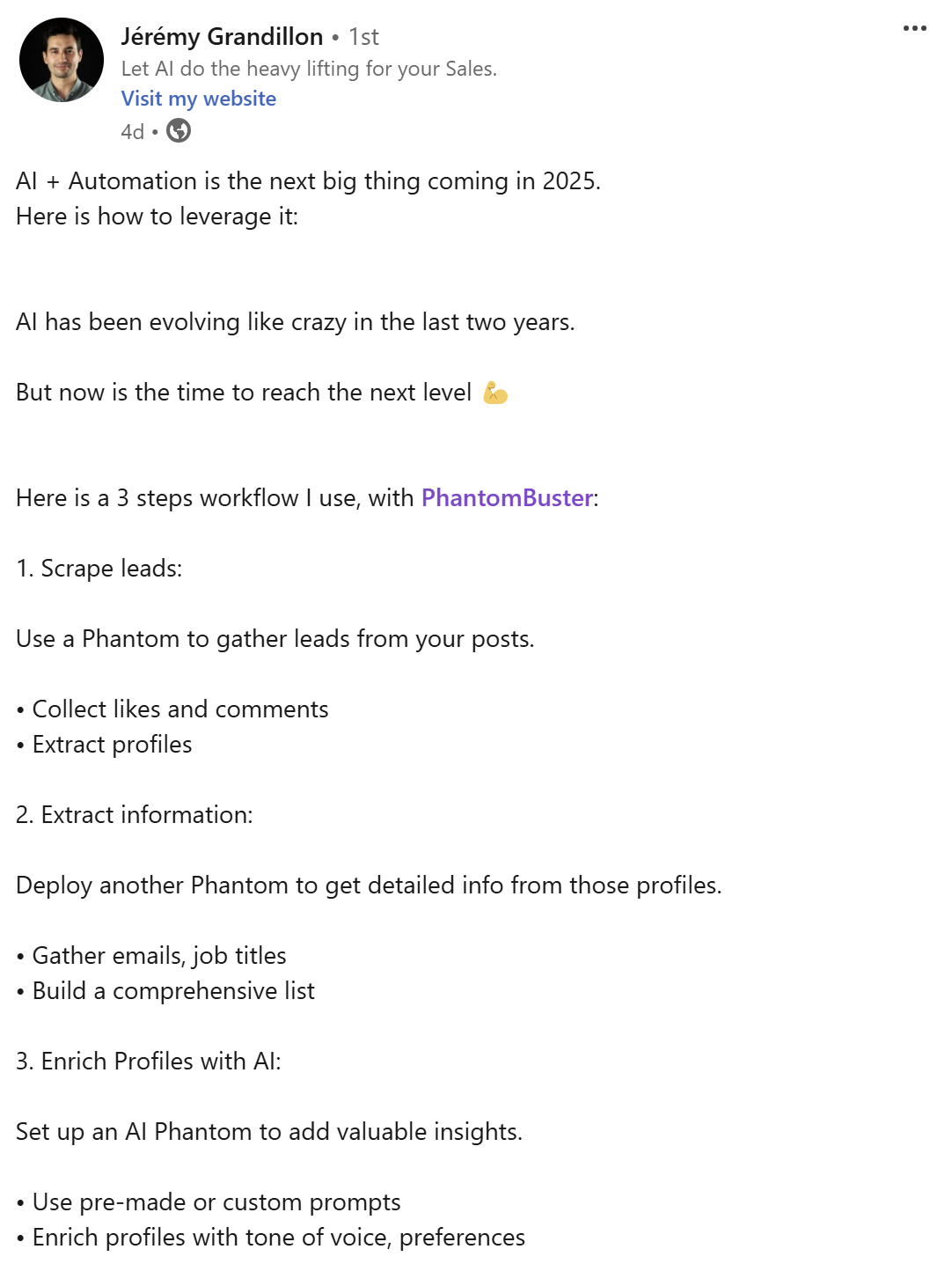
By doing this, you make sure you’re reaching out to leads more likely to convert, saving you time and ensuring you’re successful.
2. Prioritize leads based on enriched data
If you want to spend your time on the leads that matter, you need a way to sort through the noise.
That’s where PhantomBuster’s Advanced AI Enricher comes in.
For example, it can look at your lead list, compare it to your ICP, and flag the best matches for you—no guesswork involved.
All you have to do is create a prompt that spells out your ideal lead.
Let’s say you’re targeting sales managers at mid-sized European SaaS companies.
Your prompt could be:
Identify profiles in my lead list that:
– are based in Europe,
– work for SaaS companies with 100–500 employees,
– have job titles like ‘Sales Manager’ or ‘BDR Manager’,
– uses, likes or engages with HubSpot.
Return results with ‘yes’ or ‘no’ next to each profile.
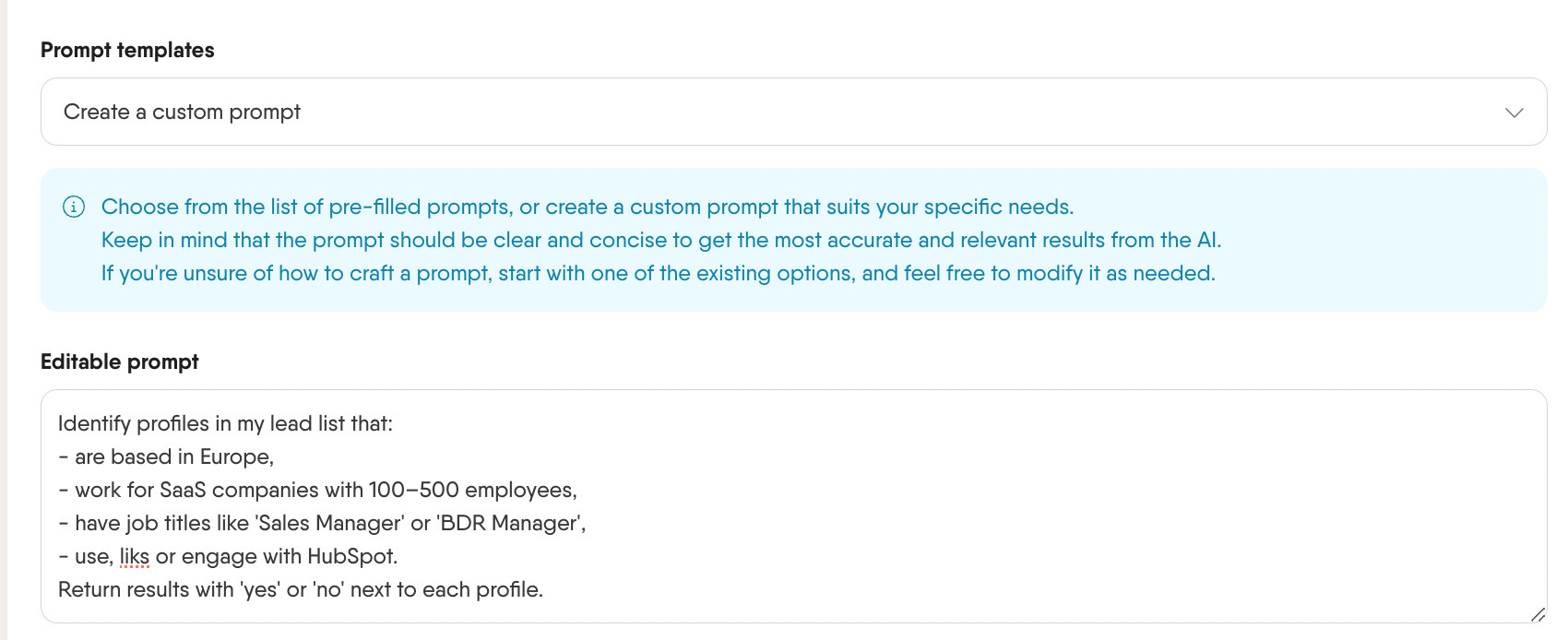
Then, let the tool do the hard work.
💡 To get even better results, check out our AI Prompt Guide. It’ll help you tweak your prompts so the tool works exactly how you need it.
3. Score your leads based on their likelihood to convert
Prioritizing the right leads makes your sales process smoother and more effective.
We recommend using the AI LinkedIn Profile Enricher to analyze lead profiles and assign scores based on their conversion likelihood.
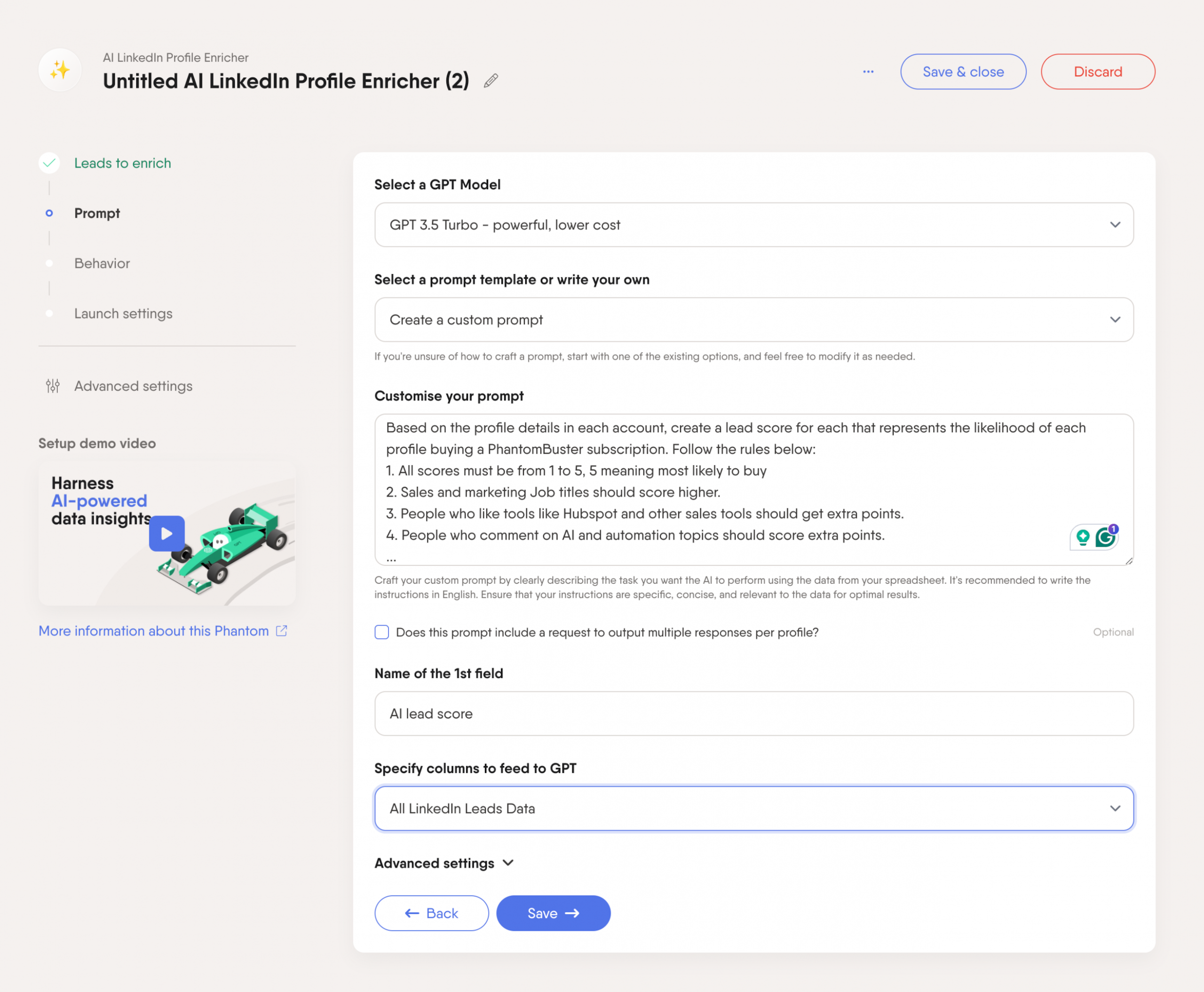
Set your scoring criteria—such as job titles, industries, or LinkedIn engagement activity—and let the tool sort your list.
For example, it can prioritize decision-makers in your target industry or highlight leads frequently engaging with related content.
This keeps your pipeline focused on prospects most likely to convert, saving you time and effort.
4. Personalize your sales outreach with AI-powered messaging
AI tools make crafting personalized outreach messages simple and effective without spending hours customizing emails or LinkedIn messages.
Try the AI LinkedIn Message Writer automation to leverage LinkedIn profile data and generate tailored messages that resonate with prospects.
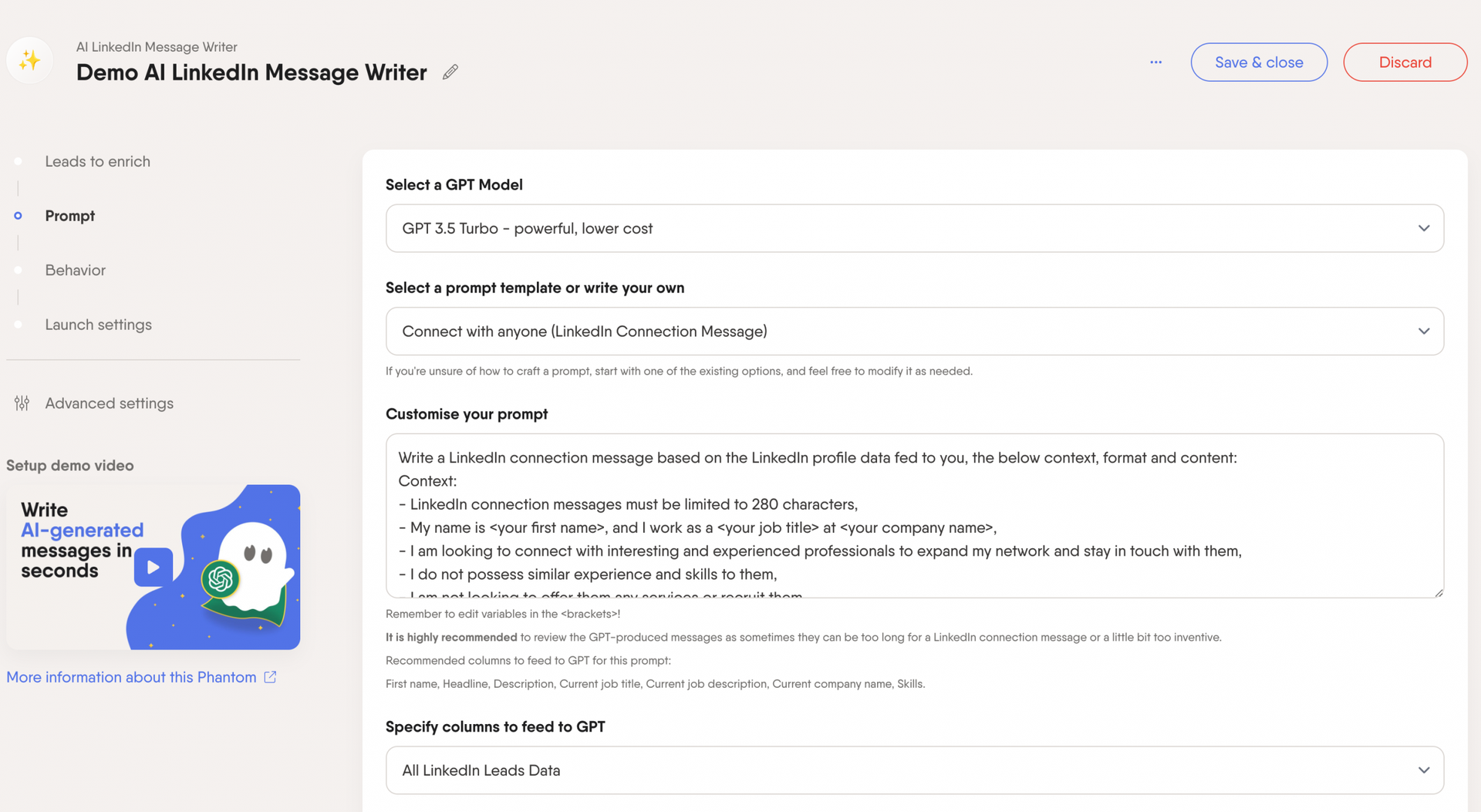
Brian, a certified PhantomBuster Coach, recommends using concise, professional messages prioritizing value and relevance.
💡 Check out his AI Prompt Guide for more tips.
For example, you can create a connection request like:
“Hi [First Name],
I noticed you’re the [Job Title] at [Company]. I’d love to connect and share how we help teams streamline lead generation.
Looking forward to connecting!”
The key is to keep your messages short, professional, and focused on the prospect’s needs and pain points.
Follow up with value-driven messages and space them out to avoid overwhelming leads.
5. Automate repetitive tasks
AI SDRs handle the repetitive work that eats up your time so that you can focus on closing deals.
Here’s how they help:
- Lead scoring: Quickly sort and prioritize leads that match your ideal customer profile.
- Follow-ups: Set up automated, well-timed follow-ups to keep prospects engaged.
- CRM data enrichment: Keep your data clean and accurate without manual entry.
- Meeting scheduling: Automate the back-and-forth of booking calls with prospects.
These tools streamline your workflow, making it easier to focus on building connections and hitting your targets.
6. Scale your sales content with AI-generated content
Scaling content for social selling doesn’t have to be overwhelming. AI tools can help you create tailored LinkedIn posts, email templates, or even conversation starters in seconds.
For instance, platforms like Taplio use engagement data to suggest content ideas that align with your audience’s interests.
This means you can share relevant, impactful content consistently, which keeps you visible and at the top of prospects’ minds.
7. Get key insights from your sales calls without manual effort
AI automation tools like Gong or Chorus do the heavy lifting when it comes to analyzing sales calls.
They break down conversations to show you what’s working and what’s not, highlighting what resonates with customers, how objections are handled, and where deals might be stalling.
Instead of spending hours replaying recordings, you get a summary of customer interactions—like how customers respond to your pitch or where deals tend to stall.
8. Deliver personalized sales training and coaching
Every sales rep has their own strengths and blind spots, so training a sales team isn’t one-size-fits-all.
AI coaching tools, like Salesforce Einstein or Gong, tailor feedback to individual performance.
They analyze metrics like talk-to-listen ratios, objection handling, and deal progression to suggest practical improvements.
This isn’t generic advice—it’s hyper-relevant to each rep’s style and challenges to help them build confidence and sharpen skills.
9. Predict sales outcomes and forecast growth with AI
Forecasting is crucial for setting realistic goals and aligning your team’s efforts.
AI tools like Clari or Salesloft analyze historical sales data, deal stages, and customer behavior to predict which opportunities will likely close.
They help you visualize these predictions and make smarter decisions about where to invest your time.
10. Analyze data and identify trends using AI
Sales data is a goldmine, but it’s easy to miss the bigger picture when you’re in the weeds.
AI tools like Gong or HubSpot analyze your metrics to highlight trends, such as which industries respond best to your outreach or which parts of your sales cycle need attention.
This matters because it lets you course-correct in real-time, improving efficiency and outcomes.
Best generative AI tools for sales professionals
Generative AI tools are reshaping how sales professionals work, from automating repetitive tasks to creating personalized outreach at scale.
Below are some top tools you can leverage to improve productivity and drive results.
PhantomBuster
PhantomBuster helps sales teams automate lead generation, enrichment, and outreach with customizable AI-powered workflows.
It’s great to:
- Automate lead scraping and sales prospecting: Extract valuable contact information from social media platforms like LinkedIn.
- Enrich lead data: Add context and insights to profiles using advanced AI features.
- Generate personalized messages: Craft tailored outreach for emails and LinkedIn with ease.
Pricing: Plans start at $56/month for 20 hours of execution time and 10,000 AI credits.
AiSDR
AiSDR streamlines prospecting and lead qualification with its intelligent AI engine designed for B2B sales teams.
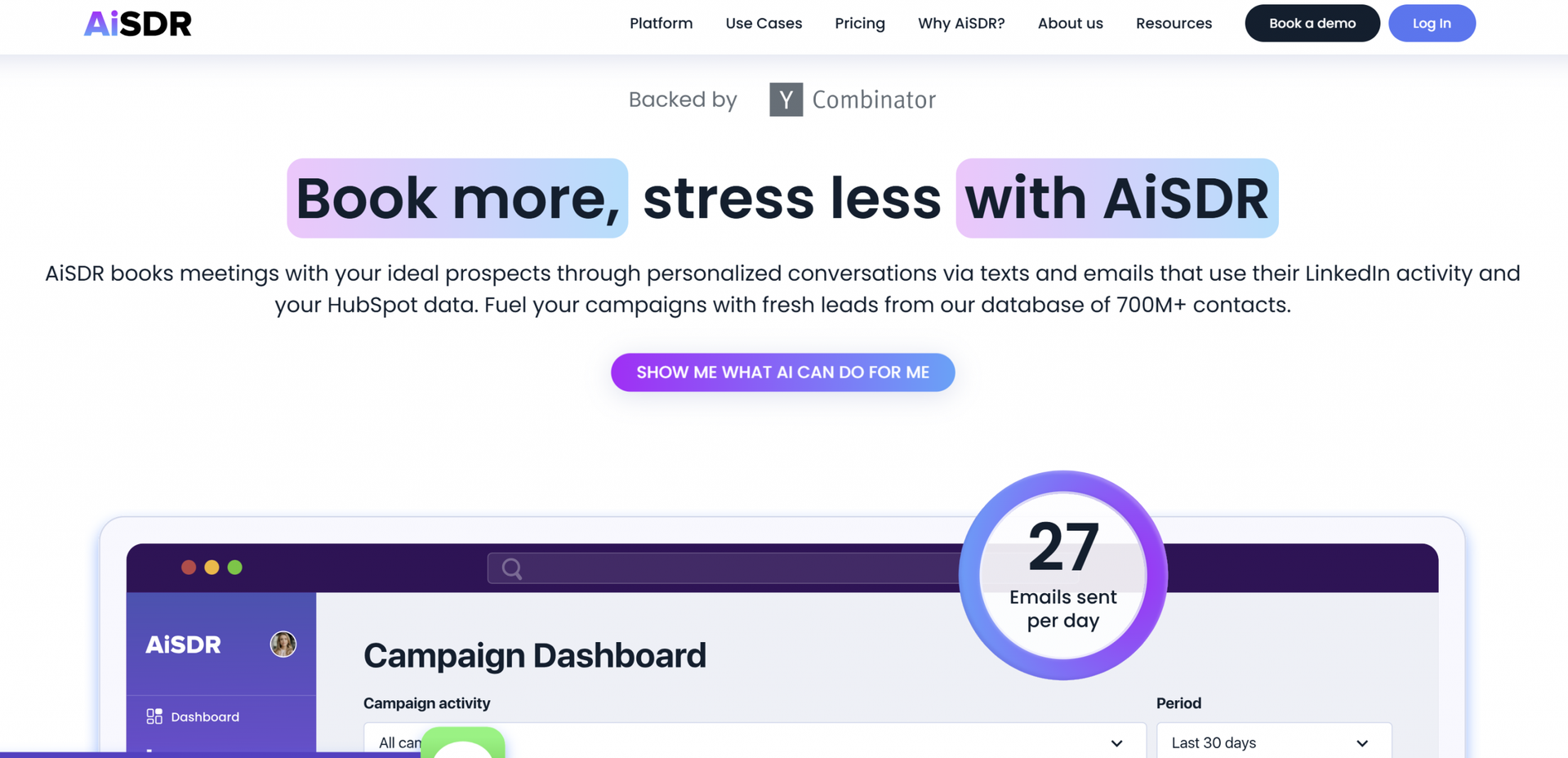
Here’s what you can do:
- Automate prospecting: Discover and qualify leads that match your ICP effortlessly.
- Personalize communication: Generate hyper-relevant outbound messages and LinkedIn InMails.
- Manage your pipeline: Track and prioritize leads with data-driven recommendations.
Pricing: Starts at $750/month for up to 1,000 personalized outreach attempts.
Gong
Gong helps sales teams unlock valuable insights from their calls by recording, transcribing, and analyzing every conversation.
This AI-driven tool identifies patterns and actionable data that improve win rates and sales strategies.
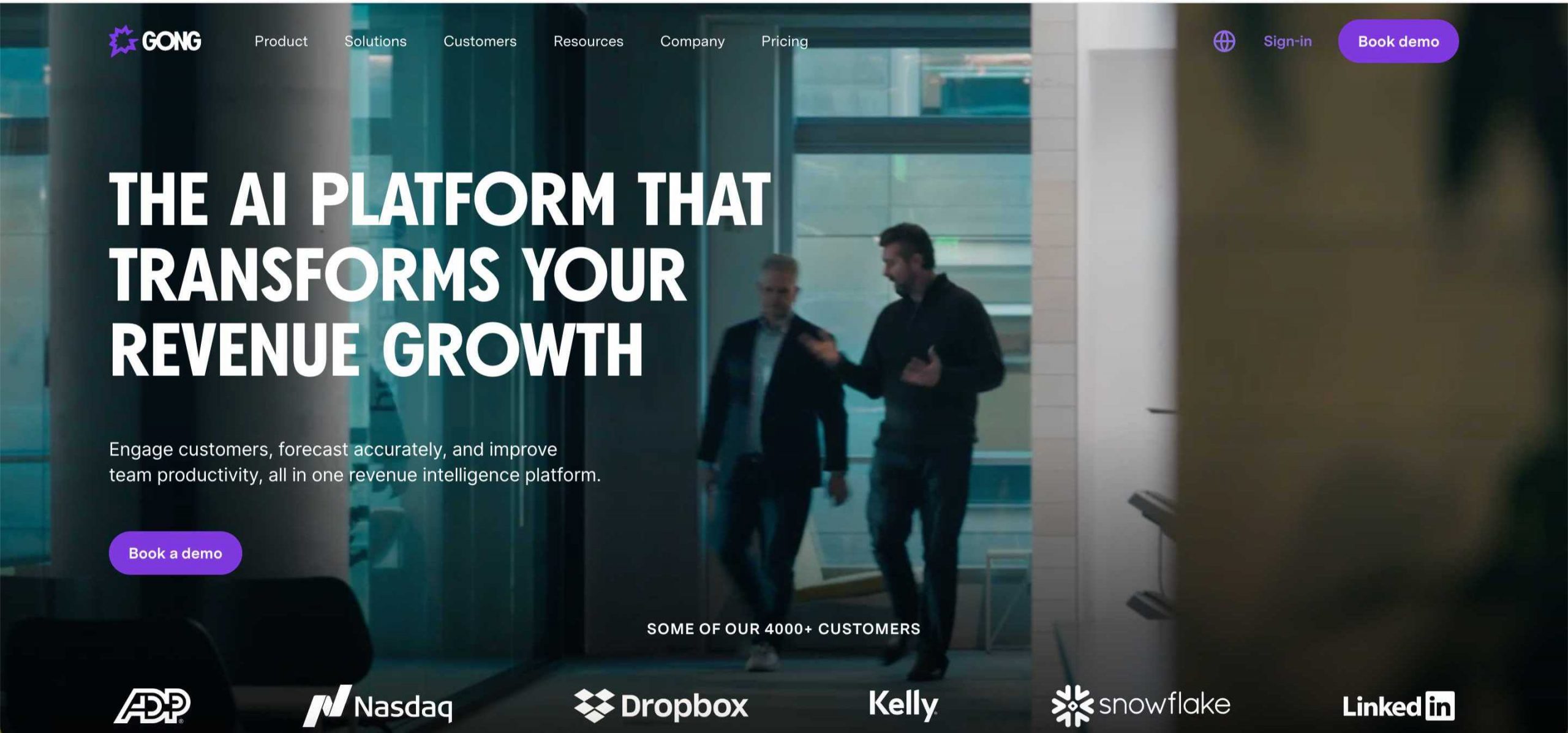
Here’s what makes it a nice generative AI tool for sales reps:
- Conversation analytics: Pinpoints trends and best practices across sales calls.
- Coaching insights: Delivers personalized recommendations for reps based on call performance.
- Deal and sales intelligence: Tracks deals in progress and flags risks or sales opportunities.
Pricing: Pricing details are available upon request.
Lavender
Lavender streamlines email outreach by helping sales reps write better, more personalized messages.
Its AI sales tools engine provides real-time feedback and optimization suggestions to increase engagement rates.

Key features include:
- Email writing assistant: Suggests edits for clarity, tone, and length.
- Personalization prompts: Guides reps on tailoring emails to individual prospects.
- Performance insights: Tracks email performance to improve future outreach.
Pricing: Plans start at $29/month per user.
Conclusion
Sales generative AI unlocks new possibilities for sales representatives, from automating repetitive tasks to driving more effective lead-generation strategies.
Ready to see how it can transform your sales growth? Try PhantomBuster’s AI-powered tools for free and start optimizing your sales process today.
